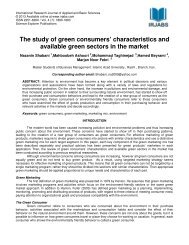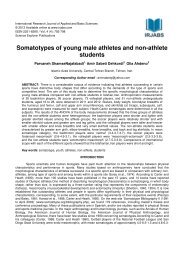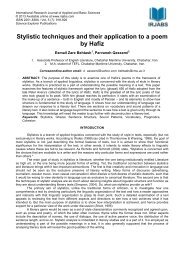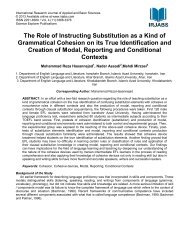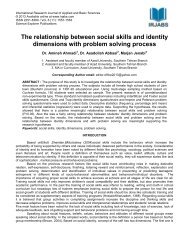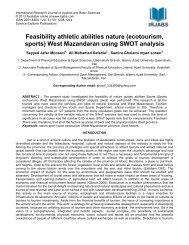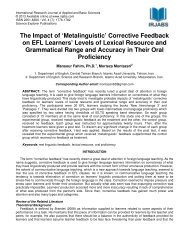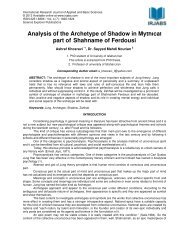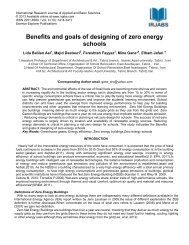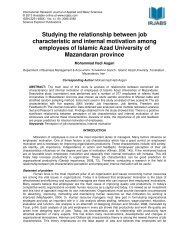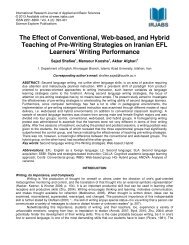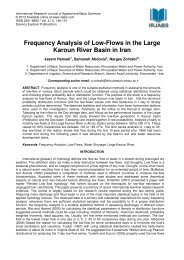The effect of different light levels on the growth of wheat Gascogne
The effect of different light levels on the growth of wheat Gascogne
The effect of different light levels on the growth of wheat Gascogne
You also want an ePaper? Increase the reach of your titles
YUMPU automatically turns print PDFs into web optimized ePapers that Google loves.
Internati<strong>on</strong>al Research Journal <str<strong>on</strong>g>of</str<strong>on</strong>g> Applied and Basic Sciences© 2012 Available <strong>on</strong>line at www.irjabs.comISSN 2251-838X / Vol, 3 (12): 2358-2363Science Explorer Publicati<strong>on</strong>s<str<strong>on</strong>g>The</str<strong>on</strong>g> <str<strong>on</strong>g>effect</str<strong>on</strong>g> <str<strong>on</strong>g>of</str<strong>on</strong>g> <str<strong>on</strong>g>different</str<strong>on</strong>g> <str<strong>on</strong>g>light</str<strong>on</strong>g> <str<strong>on</strong>g>levels</str<strong>on</strong>g> <strong>on</strong> <strong>the</strong> <strong>growth</strong> <str<strong>on</strong>g>of</str<strong>on</strong>g><strong>wheat</strong> <strong>Gascogne</strong>Elena Khabiri * and Ailar SattarzadehDepartment <str<strong>on</strong>g>of</str<strong>on</strong>g> Agr<strong>on</strong>omy and Plant Breeding, Ardabil Branch, Islamic Azad University, Ardabil, IranCorresp<strong>on</strong>ding author Email: Elena.khabiri@yahoo.comABSTRACT: To study <strong>the</strong> <str<strong>on</strong>g>effect</str<strong>on</strong>g> <str<strong>on</strong>g>of</str<strong>on</strong>g> <str<strong>on</strong>g>light</str<strong>on</strong>g> <str<strong>on</strong>g>levels</str<strong>on</strong>g> <strong>on</strong> <strong>the</strong> <strong>growth</strong> <str<strong>on</strong>g>of</str<strong>on</strong>g> <strong>wheat</strong>, was c<strong>on</strong>ducted in ArdabilIAU research greenhouse during 2010. <str<strong>on</strong>g>The</str<strong>on</strong>g> research was carried out through in-time plate splitpattern <strong>on</strong> base <str<strong>on</strong>g>of</str<strong>on</strong>g> completely randomized block in three replicati<strong>on</strong>s with two treatments. Firsttreatment in normal <str<strong>on</strong>g>light</str<strong>on</strong>g> c<strong>on</strong>diti<strong>on</strong>s and <strong>the</strong> treatment <str<strong>on</strong>g>of</str<strong>on</strong>g> <str<strong>on</strong>g>light</str<strong>on</strong>g> was red. Results suggested that inleaf area index (LAI) treatment No. 2 had a higher yield in absorbing sun<str<strong>on</strong>g>light</str<strong>on</strong>g> and red <str<strong>on</strong>g>light</str<strong>on</strong>g> led intotreatment No. 2 to produce more leaves.In crop <strong>growth</strong> rate (CGR) red <str<strong>on</strong>g>light</str<strong>on</strong>g> had a negative <str<strong>on</strong>g>effect</str<strong>on</strong>g><strong>on</strong> plant dry matter accumulati<strong>on</strong>. To put it ano<strong>the</strong>r way, red <str<strong>on</strong>g>light</str<strong>on</strong>g> caused treatment No. 2 to have alower CGR comparing to treatment No. 1. In relative <strong>growth</strong> rate (RGR) treatment No. 1 which wasexposed to normal sun<str<strong>on</strong>g>light</str<strong>on</strong>g> had a higher weight increase during <strong>growth</strong> period, comparing totreatment No. 2 which was exposed to red <str<strong>on</strong>g>light</str<strong>on</strong>g>. In net assimilati<strong>on</strong> rate (NAR) treatment No.1(normal <str<strong>on</strong>g>light</str<strong>on</strong>g>) produces more dry matter comparing to <strong>the</strong> treatment No. 2 (red <str<strong>on</strong>g>light</str<strong>on</strong>g>); that is, normal<str<strong>on</strong>g>light</str<strong>on</strong>g> has a better photosyn<strong>the</strong>tic efficiency in plant.Keywords: <strong>wheat</strong>, <strong>growth</strong> index, <str<strong>on</strong>g>light</str<strong>on</strong>g> <str<strong>on</strong>g>levels</str<strong>on</strong>g>INTRODUCTIONTriticum aestivum is <strong>the</strong> most important crop in <strong>the</strong> world. Extensive extent and high adaptati<strong>on</strong> <str<strong>on</strong>g>of</str<strong>on</strong>g> this plantas well as its diverse c<strong>on</strong>sumpti<strong>on</strong>s in <strong>the</strong> human nutriti<strong>on</strong> lead to presented as <strong>the</strong> most important cereal in <strong>the</strong>world, especially in developing countries and it can provided 20 percent food resources <str<strong>on</strong>g>of</str<strong>on</strong>g> <strong>the</strong> world people (Farziet al, 2010). Light plays a key role in plant life, determining <strong>the</strong>ir photo-morphogenesis and photosyn<strong>the</strong>sis rate(Avercheva et al., 2009). <str<strong>on</strong>g>The</str<strong>on</strong>g> sun emits <strong>the</strong> most <str<strong>on</strong>g>of</str<strong>on</strong>g> its radiati<strong>on</strong> in <strong>the</strong> visible range, it covers <strong>the</strong> range <str<strong>on</strong>g>of</str<strong>on</strong>g>wavelength from 400-700nm (Kolawole, et al., 2010). <str<strong>on</strong>g>The</str<strong>on</strong>g> integrati<strong>on</strong>, quality, durati<strong>on</strong> and intensity <str<strong>on</strong>g>of</str<strong>on</strong>g> red, far-red,blue, UV-A (320–500 nm) and UV-B (280–320 nm) <str<strong>on</strong>g>light</str<strong>on</strong>g> have a pr<str<strong>on</strong>g>of</str<strong>on</strong>g>ound influence <strong>on</strong> plants by triggeringphysiological reacti<strong>on</strong>s to c<strong>on</strong>trol <strong>the</strong>ir <strong>growth</strong> and development (Briggs et al., 2001; Briggs and Olney, 2001;Clouse, 2001). LEDs are solid-state, l<strong>on</strong>g-lasting and durable sources <str<strong>on</strong>g>of</str<strong>on</strong>g> narrow-band <str<strong>on</strong>g>light</str<strong>on</strong>g> that can be used in avariety <str<strong>on</strong>g>of</str<strong>on</strong>g> horticultural and photo-biological applicati<strong>on</strong>s (Stutte, 2009), including c<strong>on</strong>trolled research envir<strong>on</strong>ments(Avercheva et al., 2009), <str<strong>on</strong>g>light</str<strong>on</strong>g>ing for tissue culture (Li et al., 2010) and supplemental and photoperiod <str<strong>on</strong>g>light</str<strong>on</strong>g>ing forgreenhouses (Morrow, 2008). Because <str<strong>on</strong>g>of</str<strong>on</strong>g> <strong>the</strong>ir potential to be implemented in dynamic <str<strong>on</strong>g>light</str<strong>on</strong>g>ing strategies to c<strong>on</strong>trolplant <strong>growth</strong>, development, physiological resp<strong>on</strong>ses and producti<strong>on</strong>, it is important to learn more about <strong>the</strong>influence <str<strong>on</strong>g>of</str<strong>on</strong>g> <str<strong>on</strong>g>light</str<strong>on</strong>g> quality <strong>on</strong> <strong>the</strong>se processes (Folta and Childers, 2008; Lefsrud et al., 2008; Massa et al., 2008).Receiving sun<str<strong>on</strong>g>light</str<strong>on</strong>g> by <strong>the</strong> plants and using that in plant biomass indicates <strong>the</strong> fundamental processes which c<strong>on</strong>trol<strong>the</strong> crop yield (Purcell et al., 2002). Hence, <strong>on</strong>e <str<strong>on</strong>g>of</str<strong>on</strong>g> old methods in assessing plants yield is to measure <strong>the</strong> received<str<strong>on</strong>g>light</str<strong>on</strong>g> by <strong>the</strong> plant and calculate <strong>the</strong> yield in its transformati<strong>on</strong> into dry matter (Cadersa and Govinden, 1999).Photosyn<strong>the</strong>tically active radiati<strong>on</strong> (PAR) recepti<strong>on</strong> method by <strong>the</strong> plant ghosting is am<strong>on</strong>g <strong>the</strong> main determining
Intl. Res. J. Appl. Basic. Sci. Vol., 3 (12), 2358-2363, 2012RESULTS AND DISCUSSIONLeaf Area Index (LAI)Leaf Area Index (LAI) represents <strong>the</strong> ratio between crops leaves area to <strong>the</strong> area leaves cover. During<strong>growth</strong> seas<strong>on</strong>, LAI is initially low and it gradually increases and it decreases, again. Results suggested that(Diagram 1) in treatment No. 1 which was under regular <str<strong>on</strong>g>light</str<strong>on</strong>g> <strong>the</strong> LAI is increased linearly. In <strong>the</strong> treatment No. 2which was exposed to red <str<strong>on</strong>g>light</str<strong>on</strong>g>, LAI had a linear <strong>growth</strong> in <strong>the</strong> first 3 weeks while LAI had a more ascending <strong>growth</strong>in <strong>the</strong> last 2 weeks. In <strong>the</strong> comparis<strong>on</strong> between two treatments, treatment No. 2 had a higher <strong>growth</strong> subsequent to<strong>the</strong> sampling. Hence, it could be said that, treatment No. 2 had a higher yield in absorbing sun<str<strong>on</strong>g>light</str<strong>on</strong>g> and red <str<strong>on</strong>g>light</str<strong>on</strong>g> ledinto treatment No. 2 to produce more leaves.Crop Growth Rate (CGR)Crop Growth Rate is <strong>the</strong> most meaningful word in analyzing <strong>growth</strong> in plant communities. CGR determines<strong>the</strong> dry matter accumulati<strong>on</strong> in a time and land units in a plant community. CGR value is insignificant at <strong>the</strong>beginning <str<strong>on</strong>g>of</str<strong>on</strong>g> seas<strong>on</strong>, while it subsequently increases and it decreases again by <strong>the</strong> end <str<strong>on</strong>g>of</str<strong>on</strong>g> <strong>the</strong> seas<strong>on</strong>. CGR valuein this test had an ascending <strong>growth</strong>, but in short period <str<strong>on</strong>g>of</str<strong>on</strong>g> time <strong>the</strong> <strong>growth</strong> was descending and it increased again.<str<strong>on</strong>g>The</str<strong>on</strong>g> decrease seems to be due to <strong>the</strong> research errors or <strong>the</strong>rmal stress agent. C<strong>on</strong>sidering <strong>the</strong> above diagram(Diagram 2), it could be c<strong>on</strong>cluded that red <str<strong>on</strong>g>light</str<strong>on</strong>g> had a negative <str<strong>on</strong>g>effect</str<strong>on</strong>g> <strong>on</strong> plant dry matter accumulati<strong>on</strong>. To put itano<strong>the</strong>r way, red <str<strong>on</strong>g>light</str<strong>on</strong>g> caused treatment No. 2 to have a lower CGR comparing to treatment No. 1.Relative Growth Rate (RGR)RGR indicates <strong>the</strong> plant dry matter changes <strong>on</strong> initial dry weight in time unit. Subsequent to germinati<strong>on</strong>,RGR curve rises for a short period and has a decreasing trend over time. Hence, since <strong>the</strong> plant in this researchwas at <strong>the</strong> beginning <str<strong>on</strong>g>of</str<strong>on</strong>g> <strong>growth</strong> seas<strong>on</strong>, RGR must have an ascending trend. However, during <strong>the</strong> third and fourthsamples harvest, a decline was observed which seems to be due to <strong>the</strong> research error and <strong>the</strong>rmal stress agent.C<strong>on</strong>sidering <strong>the</strong> above diagram (Diagram 3), it could be c<strong>on</strong>cluded that, treatment No. 1 which was exposed t<strong>on</strong>ormal sun<str<strong>on</strong>g>light</str<strong>on</strong>g> had a higher weight increase during <strong>growth</strong> period, comparing to treatment No. 2 which wasexposed to red <str<strong>on</strong>g>light</str<strong>on</strong>g>.Net Assimilati<strong>on</strong> Rate (NAR)Net Assimilati<strong>on</strong> Rate is defined as <strong>the</strong> dry matter accumulati<strong>on</strong> in time and leaf area units. If fact, NAR is<strong>the</strong> amount <str<strong>on</strong>g>of</str<strong>on</strong>g> dry matter which is produced in leaf area unit and it indicates <strong>the</strong> leaves photosyn<strong>the</strong>tic efficiency inplant communities. NAR has <strong>the</strong> highest value at <strong>the</strong> beginning <str<strong>on</strong>g>of</str<strong>on</strong>g> <strong>growth</strong> seas<strong>on</strong>, but, it increases by <strong>the</strong> increasein leaf area. NAR in both treatments <str<strong>on</strong>g>of</str<strong>on</strong>g> this research was ascending which seems to be due to <strong>the</strong> research errorand <strong>the</strong>rmal stress agent that shows a descending trend in a short time. However, c<strong>on</strong>sidering <strong>the</strong> results (Diagram4), it could be generally deduced that treatment No.1 (normal <str<strong>on</strong>g>light</str<strong>on</strong>g>) produces more dry matter comparing to <strong>the</strong>treatment No. 2 (red <str<strong>on</strong>g>light</str<strong>on</strong>g>); that is, normal <str<strong>on</strong>g>light</str<strong>on</strong>g> has a better photosyn<strong>the</strong>tic efficiency in plant.Leaf Area Ratio (LAR)LAR is <strong>the</strong> plant leaf surface to total plant weight ratio. In o<strong>the</strong>r words, LAR is <strong>the</strong> surface <str<strong>on</strong>g>of</str<strong>on</strong>g> photosyn<strong>the</strong>tictissues to plant respirati<strong>on</strong> tissues weight ratio. LAR could indicate a plant’s Full leaf and also plant’s investment <strong>on</strong>producing leaves. Research results (Diagram 5) suggest that treatment No. 2 which was exposed to red <str<strong>on</strong>g>light</str<strong>on</strong>g> had ahigher leaf area during <strong>the</strong> <strong>growth</strong> period, comparing to treatment No. 1 which was exposed to normal <str<strong>on</strong>g>light</str<strong>on</strong>g>. It couldbe c<strong>on</strong>cluded that red <str<strong>on</strong>g>light</str<strong>on</strong>g> had stimulated treatment No. 2 to produce more leaves.Specific Leaf Area (SLA)Specific Leaf Area is defined as <strong>the</strong> leaf area to leaf dry weight. SLA indicates <strong>the</strong> leaf thickness and <strong>the</strong>higher <strong>the</strong> SLA value, <strong>the</strong> thinner <strong>the</strong> leaf and vice versa. Research results (Diagram 6) suggests that SLA value isdescending and while treatment No. 2 was exposed to <strong>the</strong>rmal stress, this decrease was higher. However, afterremoving stress, it was back to normal. Factors such as drought stress or intense <str<strong>on</strong>g>light</str<strong>on</strong>g> result in increase in leafthickness and c<strong>on</strong>sequently decrease in SLA. It could be generally c<strong>on</strong>cluded that, comparing to treatment No. 1(normal <str<strong>on</strong>g>light</str<strong>on</strong>g>), treatment No. 2 (red <str<strong>on</strong>g>light</str<strong>on</strong>g>) has thinner leaves. Hence, treatment No. 2 has a lower photosyn<strong>the</strong>ticpower, comparing to treatment No. 1.2360
Intl. Res. J. Appl. Basic. Sci. Vol., 3 (12), 2358-2363, 2012Leaf Weight Ratio (LWR)LWR is defined as <strong>the</strong> leaf dry weight to plant total dry weight ratio. Research results (Diagram 7) suggestthat, LWR in both treatments are almost similar. However, at <strong>the</strong> beginning <str<strong>on</strong>g>of</str<strong>on</strong>g> <strong>the</strong> <strong>growth</strong> seas<strong>on</strong>, LWR in treatmentNo. 2 is higher than treatment No. 1. This linear <strong>growth</strong> could be due to <strong>the</strong> red <str<strong>on</strong>g>light</str<strong>on</strong>g> <str<strong>on</strong>g>effect</str<strong>on</strong>g>.Burestall and Harris (1983) in a research <strong>on</strong> potato showed that <str<strong>on</strong>g>light</str<strong>on</strong>g> absorpti<strong>on</strong> percentage has a linearand curve-linear relati<strong>on</strong> with soil coverage percentage and leaf area ratio, respectively; that is, <strong>the</strong> soil coveragepercentage and <str<strong>on</strong>g>light</str<strong>on</strong>g> absorpti<strong>on</strong> percentage are c<strong>on</strong>stant during <strong>growth</strong> seas<strong>on</strong>, but <strong>the</strong> relati<strong>on</strong> between leaf arearatio and <str<strong>on</strong>g>light</str<strong>on</strong>g> absorpti<strong>on</strong> percentage differs in <strong>the</strong> beginning and at <strong>the</strong> end <str<strong>on</strong>g>of</str<strong>on</strong>g> <strong>the</strong> <strong>growth</strong> seas<strong>on</strong> (QasemiGol’azani et al., 1998). Green coverage percentage is a determining index in <strong>growth</strong> (Qasemi Gol’azani et al.,1998) and has practical advantages such as quick and n<strong>on</strong>-destructive measurement which provides <strong>the</strong> possibility<str<strong>on</strong>g>of</str<strong>on</strong>g> observati<strong>on</strong> for several times during <strong>growth</strong> period. Hence, it could be used as <strong>on</strong>e <str<strong>on</strong>g>of</str<strong>on</strong>g> <strong>growth</strong> indices appropriatefor estimating crops potential yield in farms. In black eyed peas, a close correlati<strong>on</strong> has been observed betweenyield and leaf area ratio during flowering last stages (Turk and Hall, 1980). High amount <str<strong>on</strong>g>of</str<strong>on</strong>g> green coveragepercentage especially during grain filling critical period could decrease water vaporizati<strong>on</strong> from soil surface andincrease water amount available for <strong>the</strong> plant and hence increase in <strong>the</strong> amount. <str<strong>on</strong>g>The</str<strong>on</strong>g>re is a direct positivecorrelati<strong>on</strong> found Between <str<strong>on</strong>g>light</str<strong>on</strong>g> absorpti<strong>on</strong> ratio by <strong>the</strong> plant vegetati<strong>on</strong> and some o<strong>the</strong>r <strong>growth</strong> indices such as leafarea ratio (Mwanamwenga et al., 1999) and soil coverage percentage (Burestall and Harris, 1983), so that, bymeasuring such indices, <strong>the</strong> <str<strong>on</strong>g>light</str<strong>on</strong>g> absorpti<strong>on</strong> by a plant could be estimated.2361
Intl. Res. J. Appl. Basic. Sci. Vol., 3 (12), 2358-2363, 2012REFERENCESAsseng, so, Jamies<strong>on</strong> PD, Kimball B, pinter P, sayra K, Bowden JW, Howden SM, 2004. simulated <strong>wheat</strong> <strong>growth</strong> affected by rising temperature,in creased water deficit and elevated atmospheric coz. Field crops Res. 85: 85-102.Avercheva, O.V., Berkovich, Y.A., Erokhin, A.N., Zhigalova, T.V., Pogosyan, S.I., & Smolyanina, S.O, 2009. Growth and photosyn<strong>the</strong>sis <str<strong>on</strong>g>of</str<strong>on</strong>g>Chinese cabbage plants grown under <str<strong>on</strong>g>light</str<strong>on</strong>g>-emitting diode-based <str<strong>on</strong>g>light</str<strong>on</strong>g> source. Russian Journal <str<strong>on</strong>g>of</str<strong>on</strong>g> Plant Physiology, 56, 14-21.http://dx.doi.org/10.1134/S1021443709010038B<strong>on</strong>homme R, 2000. Beware <str<strong>on</strong>g>of</str<strong>on</strong>g> comparing RUE values calculated from PAR vs. solar radati<strong>on</strong> or observed vs. intercepted radiati<strong>on</strong>. Field CropRes. 68: 247-252.Briggs, W.R., Beck, C.F., Cashmore, A.R., Christie, J.M., & Hunghes, J, 2001. <str<strong>on</strong>g>The</str<strong>on</strong>g> phototropin family <str<strong>on</strong>g>of</str<strong>on</strong>g> photoreceptors. Plant Cell, 13, 993-997.http://dx.doi.org/10.1105/tpc.13.5.993Briggs, W.R., & Olney, M.A, 2001. Photoreceptors in plant photomorphogenesis to date, five photochromes, two cryptochrome, <strong>on</strong>e phototropinand <strong>on</strong>e superchrome. Plant Physiology, 25, 85-88. http://dx.doi.org/10.1104/pp.125.1.85Burstall L, Harris PM, 1983. <str<strong>on</strong>g>The</str<strong>on</strong>g> estimati<strong>on</strong> <str<strong>on</strong>g>of</str<strong>on</strong>g> percentage <str<strong>on</strong>g>light</str<strong>on</strong>g> intercepti<strong>on</strong> from leaf area index and percentage ground cover in potatoes. J.Agric. Sci. 100: 241-244.Cadersa Y, Govinden N, 1999. Relati<strong>on</strong> ship between. Canopy cover and <str<strong>on</strong>g>light</str<strong>on</strong>g> intercepti<strong>on</strong> in potato in a tropical climate. Food and Agric. Res.Council, 137-144.Caliskan S, Ozakaya I, caliskan ME, Arslan M, 2008. <strong>the</strong> <str<strong>on</strong>g>effect</str<strong>on</strong>g>s <str<strong>on</strong>g>of</str<strong>on</strong>g> nitrogen and ir<strong>on</strong> fertilizati<strong>on</strong> <strong>on</strong> <strong>growth</strong>, yield and fertilizer use efficiency <str<strong>on</strong>g>of</str<strong>on</strong>g>soybean in a Mediterranean type soil. Field crops Res. 108: 126-132.Clouse, S.D, 2001. Integrati<strong>on</strong> <str<strong>on</strong>g>of</str<strong>on</strong>g> <str<strong>on</strong>g>light</str<strong>on</strong>g> and brassinosteroid signals in etiolated seedling <strong>growth</strong>. Trends in Plant Science, 6, 443-445.http://dx.doi.org/10.1016/S1360-1385(01)02102-1.Egli DB, Guffy RG, Leggett JE, 1985. partiti<strong>on</strong>ing <str<strong>on</strong>g>of</str<strong>on</strong>g> assimilate between vegetative and reproductive <strong>growth</strong> in soybean. Agr<strong>on</strong>. J. 77: 917-922.Ghasemi Golazany K, Movahedi M, Rahimzadeh Khoei F, Moghaddam M, 1998. Effects <str<strong>on</strong>g>of</str<strong>on</strong>g> waterdeficit <strong>on</strong> <strong>growth</strong> and yield <str<strong>on</strong>g>of</str<strong>on</strong>g> chickpea cultivarsatvarious densities. Journal <str<strong>on</strong>g>of</str<strong>on</strong>g> Agricultural Science, Volume 7, Number 3 and 4. Page 42-17.Farzi, A. and B. Shekari Mosta'li Bigloo, 2010. Evaluati<strong>on</strong> <str<strong>on</strong>g>of</str<strong>on</strong>g> genetic diversity <str<strong>on</strong>g>of</str<strong>on</strong>g> <strong>wheat</strong> lines by related traits to drought tolerance. <str<strong>on</strong>g>The</str<strong>on</strong>g> 11thIranian C<strong>on</strong>gress <str<strong>on</strong>g>of</str<strong>on</strong>g> Agr<strong>on</strong>omy Science and Plant Breeding, pp: 155-157.Folta, K.M., & Childers, K.S, 2008. Light as a <strong>growth</strong> regulator: c<strong>on</strong>trolling plant biology with narrow-bandwidth solid-state <str<strong>on</strong>g>light</str<strong>on</strong>g>ing systems.HortScience, 43, 1957-1964. http://hortsci.ashspublicati<strong>on</strong>s.org/c<strong>on</strong>tent/43/7/1957.fullHusain MM, Hill GD, Gallagher JN, 1988. <str<strong>on</strong>g>The</str<strong>on</strong>g> resp<strong>on</strong>se <str<strong>on</strong>g>of</str<strong>on</strong>g> field beans to irrigati<strong>on</strong> and sowing date. II. Growth and development in relati<strong>on</strong> toyield Agri. Sci. camb. 3: 233- 254.Kaushal T, <strong>on</strong>da M, Ito S, Yamazaki A, Fujikake, ohtake N, sueyoshi K, Takahashi Y, ohyama T, 2006. Effect <str<strong>on</strong>g>of</str<strong>on</strong>g> placement <str<strong>on</strong>g>of</str<strong>on</strong>g> show- releaseFertilizer applied at <str<strong>on</strong>g>different</str<strong>on</strong>g> rates <strong>on</strong> <strong>growth</strong>, N. Fixati<strong>on</strong> and yield <str<strong>on</strong>g>of</str<strong>on</strong>g> soybean. J. Agr<strong>on</strong>omy and crop science, 192: 417-426.Kolawole, O. M., Kayode, R. M. O., & Aina, J, 2010. <str<strong>on</strong>g>The</str<strong>on</strong>g> drying <str<strong>on</strong>g>effect</str<strong>on</strong>g> <str<strong>on</strong>g>of</str<strong>on</strong>g> varying <str<strong>on</strong>g>light</str<strong>on</strong>g> frequencies <strong>on</strong> <strong>the</strong> proximate and microbial compositi<strong>on</strong> <str<strong>on</strong>g>of</str<strong>on</strong>g>tomato. Journal <str<strong>on</strong>g>of</str<strong>on</strong>g> Agricultural Science, 2, 214-224. http://www.ccsenet.org/jas.Lefsrud, M.G., Kopsell, D.A., & Sams, C.E, 2008. Irradiance from distinct wavelength <str<strong>on</strong>g>light</str<strong>on</strong>g>-emitting diodes affect sec<strong>on</strong>dary metabolites in Kale.HortScience, 43, 2243-2244. http://trace.tennessee.edu/utk_planpubs/6.Li, H. M., Xu, Z. G., & Tang, C. M, 2010. Effect <str<strong>on</strong>g>of</str<strong>on</strong>g> <str<strong>on</strong>g>light</str<strong>on</strong>g>-emitting diodes <strong>on</strong> <strong>growth</strong> and morphogenesis <str<strong>on</strong>g>of</str<strong>on</strong>g> upland cott<strong>on</strong> (Gossypium hirsutum L.)plantlets in vitro. Plant Cell Tissue Orgure Culture, 103, 155–163. http://dx.doi.org/10.1007/s11240-010-9763-zLind quist JL, Arkebauer TJ, walters DT, cassman KG, Dobermann A, 2005. Maize radiati<strong>on</strong> use efficiency under optimal <strong>growth</strong> c<strong>on</strong>diti<strong>on</strong>.Agr<strong>on</strong>. J. 97: 72-78.Massa, G.D., Kim, H.H., Wheeler, R.M., & Mitchell, C.A, 2008. Plant productivity in resp<strong>on</strong>se to LED <str<strong>on</strong>g>light</str<strong>on</strong>g>ing. HortScience, 43, 1951–1956.http://hortsci.ashspublicati<strong>on</strong>s.org/c<strong>on</strong>tent/43/7/1951.full.Mohammed Gh, Golazany Ghasemi K, Jvanshyr A, Moghaddam M, 2006. Effect <str<strong>on</strong>g>of</str<strong>on</strong>g> water restricti<strong>on</strong> <strong>on</strong> <strong>the</strong> performance <str<strong>on</strong>g>of</str<strong>on</strong>g> pea cultivars.Agricultural Sciences and Natural Resources, <strong>the</strong> tenth year, Number 2, Pages 119-109.Morrow, R.C, 2008. LED Lighting in Horticulture. HortScience, 43, 1947-1950. http://hortsci.ashspublicati<strong>on</strong>s.org/c<strong>on</strong>tent/43/7/1947.full.2362
Intl. Res. J. Appl. Basic. Sci. Vol., 3 (12), 2358-2363, 2012Mwanamwenge J, Joss SP, siddique KHM, cocks PS, 1999. Effects <str<strong>on</strong>g>of</str<strong>on</strong>g> water stress during floral initiati<strong>on</strong>, flowering and podding <strong>on</strong> <strong>the</strong> <strong>growth</strong>and yield <str<strong>on</strong>g>of</str<strong>on</strong>g> faba bean. European J. Agr<strong>on</strong>. 11: 1-11.Purcell LC, Ball RA, Reaper JD, vories ED, 2002. Radiati<strong>on</strong> use efficiency and biomass producti<strong>on</strong> in soybean at <str<strong>on</strong>g>different</str<strong>on</strong>g> plant populati<strong>on</strong>densities. Crop sci. 42: 172-177.Schussler JR, Westgate ME, 1991. Maize kernel set at low water potential: I. Sensitivity to reduce assimilates during early kernel <strong>growth</strong>. CropSci. 31:1189-1195.Shafiq M, Rashed M, Mahalati (H), Nassiri M, 2006. <str<strong>on</strong>g>The</str<strong>on</strong>g> <str<strong>on</strong>g>effect</str<strong>on</strong>g> <str<strong>on</strong>g>of</str<strong>on</strong>g> cattle <strong>on</strong> cott<strong>on</strong> yield and yield comp<strong>on</strong>ents <str<strong>on</strong>g>of</str<strong>on</strong>g> soybean plants at <str<strong>on</strong>g>different</str<strong>on</strong>g>densities and <str<strong>on</strong>g>different</str<strong>on</strong>g> planting dates. Iranian Agricultural Research magazine. Volume 4. N1. Page 71-81.Stewart DW, Costa C, Dwyer LM, smith DL, Hamilt<strong>on</strong> RI, Ma BL, 2003. canopy structure <str<strong>on</strong>g>light</str<strong>on</strong>g> intercepti<strong>on</strong>, and photosyn<strong>the</strong>sis in maze. Agr<strong>on</strong>.J. 95: 1465.Stutte, G.W., Edney, S., & Skerritt, T, 2009. Photoregulati<strong>on</strong> <str<strong>on</strong>g>of</str<strong>on</strong>g> bioprotectant c<strong>on</strong>tent <str<strong>on</strong>g>of</str<strong>on</strong>g> red leaf lettuce with <str<strong>on</strong>g>light</str<strong>on</strong>g>-emitting diodes. HortScience,44, 79-82. http://hortsci.ashspublicati<strong>on</strong>s.org/c<strong>on</strong>tent/44/1/79.full.Turk KJ, Hall AE, 1980. Drought adapti<strong>on</strong> <str<strong>on</strong>g>of</str<strong>on</strong>g> cowpea, III. Influence <str<strong>on</strong>g>of</str<strong>on</strong>g> drought <strong>on</strong> plant <strong>growth</strong> and relati<strong>on</strong>s with seed yield Agr<strong>on</strong>. J. 72: 428-433.Wolf J, Van oijen M, kempenear C, 2002. Analysis <str<strong>on</strong>g>of</str<strong>on</strong>g> <strong>the</strong> experimental variability in <strong>wheat</strong> resp<strong>on</strong>se to elevated coz and temperature. Agric. Eco.Env. 93: 227-247.Yano T, Aydin M, Haragu chi T, 2007. Impact <str<strong>on</strong>g>of</str<strong>on</strong>g> climate change <strong>on</strong> irrigati<strong>on</strong> demand and crop <strong>growth</strong> in a Mediterranean envir<strong>on</strong>ment <str<strong>on</strong>g>of</str<strong>on</strong>g>Turkey. Sensors, 7: 2297-2315.2363



